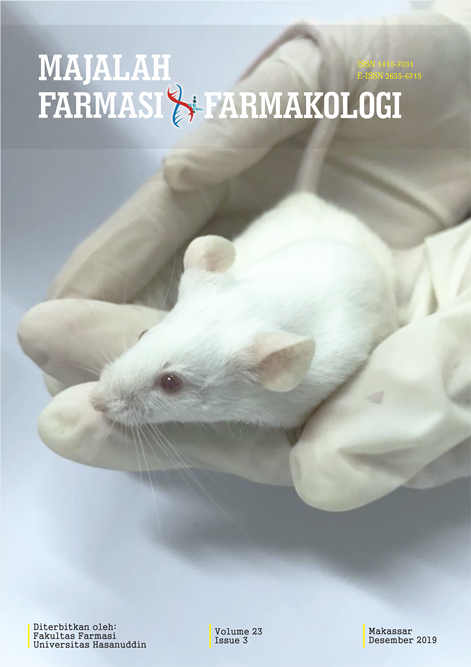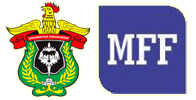ANALISIS RESIDU PESTISIDA KLORPIRIFOS PADA BERAS (Oryza sativa) YANG BERASAL KECAMATAN BAEBUNTA KABUPATEN LUWU UTARA
Abstract
Penggunaan pestisida di Indonesia sudah merupakan bagian yang tidak terpisahkan dalam sistem pertanian. Klorpirifos merupakan salah satu kelompok pestisida golongan organofosfat yang banyak digunakan untuk membunuh berbagai serangga. Adanya residu klorpirifos dapat menyebabkan gangguan kesehatan sehingga deteksi residu klorpirifos dalam produk pangan merupakan hal yang penting. Penelitian ini dilakukan untuk mengetahui kadar residu klorpirifos pada beras yang berasal dari Kecamatan Baebunta, Kabupaten Luwu Utara dan keamanannya untuk dikonsumsi. Sampel beras diambil langsung dari beberapa petani di Kecamatan Baebunta, Kabupaten Luwu Utara. Sampel diekstraksi dan di clean-up menggunakan metode QuEChERS dan dianalisis menggunakan GC/MS. Kadar residu klorpirifos dibandingkan dengan standar Batas Maksimum Residu (BMR)pada SNI. Hasil penelitian menunjukkan bahwa residu klorpirifos pada sampel A, B dan C masing-masing sebesar 0,133; 0,092; dan 0,308 mg/kg. Dengan demikian, beras yang berasal dari Kecamatan Baebunta Kabupaten Luwu Utara memiliki kadar residu di bawah nilai BMR (0,5 mg/kg) sehingga aman untuk dikonsumsiReferences
Badan pusat statistik. Distribusi perdagangan komuditas cabai merah Badan Pusat Statistik. 2017. Pengeluaran untuk Konsumsi Penduduk Indonesia per provinsi. Jakarta.
Widiarta, I.N. dan Suharto, H. 2009. Pengendalian Hama dan Penyakit Tanaman Padi Secara Terpadu. Badan Penelitian dan Pengembangan Pertanian-Balitbangtan. 441-442.
Balingtan. 2013. Teknologi menurunkan residu pestisida di lahan pertanian (Online).
(http://balingtan.litbang.pertanian.go.id/ind/index.php/berita/138-teknologi menurunkan-residu-pestisida-di-lahan-pertanian, Diakeses 8 juli 2019).
Puspitasari, D. W. dan Khaeruddin. 2016. Kajian Bioremediasi pada Tanah Tercemar Pestisida. KOVALEN. 2(3):98-106.
Runia, Y.A. 2008. Faktor-Faktor yang Berhubungan dengan Keracunan Pestisida Organofosfat, Karbamat dan Kejadian Anemia pada Petani Hortikultura di Desa Tejosari Kecamatan Ngablak Kabupaten Megelang. Tesis tidak diterbitkan. Semarang. Program Pascasarjana Universitas Diponegoro Semarang.
Badan Standarisasi Nasional. 2008. Batas Maksimum Residu Pestisida Pada Hasil Pertanian. SNI 7313:2008, ICS 65.100.01. BadanStandarisasi Nasional. Jakarta. Hal. 80.
Anastassiades, M., Lehotay, S.J., Stajnbaher, D.and Schenck, F.J. 2003. Fast and Easy Multiresidue Method Employing Acetonitrile Extraction/Partitioning and “Dispersive Solid-Phase Extraction” for The Determination of Pesticide Residues in Produce. Journal of AOAC International. 86:412-431
Mastovska, K., and Lehotay, S.J. 2004. Evaluation of Common Organic Solvents for Gas Chromatographic Analysis and Stability of Multiclass Pesticide Residues. Journal of Chromatography A, 1040: 259-272.
Lee SR, Mourer CR, Shibamoto T. 1991. Analysis before and after cooking processes of a trace chlorpyrifos spiked in polished rice. J Agric Food Chem 39:906–908
Anonim, 2001. Pedoman Cara Penggunaan Pestisida dengan Residu Minimum. Direktorat perlindungan Hortikultura, Direktorat Jendral Bina Produksi Horttikultura, Departemen Pertanian RI.Jakarta.
World Health Organization (WHO). 2004. Who Specifications and Evaluations for Public Health Pesticides, Chlorpyrifos (O,O-diethyl O-3,5,6-trichloro-2-pyridyl phosphorothioate).
Fitriadi, B.R. dan Putri, A.C., 2016. Metode-metode Pengurangan Residu Pestisida pada Hasil Pertanian. Jurnal Rekayasa Kimia dan Lingkungan. 11(2):61-71.
Downloads
Published
Issue
Section
License
The copyright to this article is transferred to Universitas Hasanuddin (UNHAS) if and when the article is accepted for publication. The undersigned hereby transfers all rights in and to the paper including without limitation all copyrights to UNHAS. The undersigned hereby represents and warrants that the paper is original and that he/she is the author of the paper, except for material that is clearly identified as to its original source, with permission notices from the copyright owners where required. The undersigned represents that he/she has the power and authority to make and execute this assignment.
We declare that:
- This paper has not been published in the same form elsewhere.
- It will not be submitted anywhere else for publication prior to acceptance/rejection by this Journal.
- A copyright permission is obtained for materials published elsewhere and which require this permission for reproduction.
Furthermore, I/We hereby transfer the unlimited rights of publication of the above-mentioned paper in whole to UNHAS The copyright transfer covers the exclusive right to reproduce and distribute the article, including reprints, translations, photographic reproductions, microform, electronic form (offline, online) or any other reproductions of similar nature.
The corresponding author signs for and accepts responsibility for releasing this material on behalf of any and all co-authors. This agreement is to be signed by at least one of the authors who have obtained the assent of the co-author(s) where applicable. After submission of this agreement signed by the corresponding author, changes of authorship or in the order of the authors listed will not be accepted.


